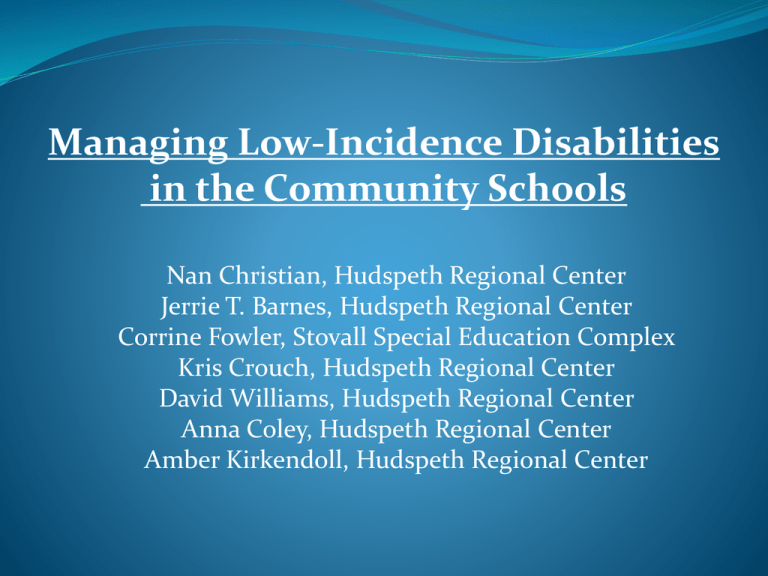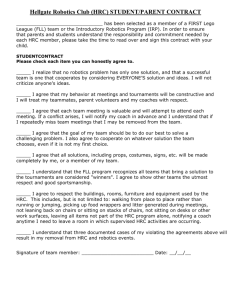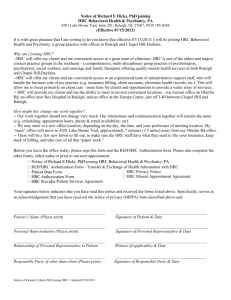Inclusion of Low-Incidence Disabilities in Community Schools
advertisement

Managing Low-Incidence Disabilities in the Community Schools Nan Christian, Hudspeth Regional Center Jerrie T. Barnes, Hudspeth Regional Center Corrine Fowler, Stovall Special Education Complex Kris Crouch, Hudspeth Regional Center David Williams, Hudspeth Regional Center Anna Coley, Hudspeth Regional Center Amber Kirkendoll, Hudspeth Regional Center Integrating individuals with low-incidence disabilities into the community schools requires addressing programming in the areas of communication, self/help skills and daily living skills, pre-vocational/work activities, transitioning skills, leisure activities, and behavior training. Several school officials representing the IDD programs will address each of these programming areas for this population and tell about/show materials that can be used. A Resource Manual will be available for each participant. I. Introduction A. Define Low-Incidence Disabilities B. Agreements between IDD Programs and Community Schools II. Programming Areas to Consider During the Integration of LowIncidence Disabilities A. Communication Skills * A variety of different systems * To present our wants, needs, opinions, likes, dislikes, etc. to another person(s) * Pointing, gesturing, actual items, pictures, icons, and pictures/words * Augmentative Communication systems (see handouts) B. Self-Help/Daily Living Skills iTalk 2 by AbleNet BigMack by AbleNet Cheap Talk 4 In-line – by Enabling Devices/Toys for Special Children Go Talk 9+ by Attainment Company, Inc. Go Talk 20+ by Attainment Company, Inc. iPad - Sounding Board by AbleNet B. Self-Help/Daily Living Skills * Skills that make it easier to go throughout our daily activities without assistance from any other outside source. Visual Schedules Reducing Distraction Peer Buddies Time On Task Motivation/Task Completion Motivation/Task Completion Daily Living Skills * Skills related to dressing, grooming, feeding, hygiene, etc. that a person must master to be independent in a daily routine. Feeding Feeding Toileting Toileting C. Vocational * Training begins in the classroom and progresses into the work setting. * Assess strengths and weaknesses. (see handout) * Teach simple skills that might be overlooked. * Determine what vocational areas the student needs to focus on and train specifically. * Determine what types of supports each individual might need. * Vocational training and activities. When assessing work behavior, it is recommended to start from the beginning and try to be as specific as possible, based on the individual student’s needs. This area can include everything from: * do they arrive to work on time; * do they report to work on time; * are they able to set the area up for work task, and if so, at what level; * if they make mistakes, can they recognize their own mistakes and correct them; * do they cooperate with supervisors and other employees? When in the classroom, you can teach simple skills that might be overlooked but will help in a work environment and in the community as well. These skills can include: * helping others; * reporting to their area or desk; * arriving on time; * sweeping and keeping their area neat and clean; * helping to take out trash and other materials. Simple Assembly Simple Assembly Adaptive Equipment Dining Packet Jig Dining Packet Jig Sealer Jig Some of the skills needed to work in this area include: * being able to report to work and sign or clock in; * being able to follow instructions; * having a good attitude; * possibly having to lift heavy materials; * using basic equipment such as a food slicer, a food warmer, and possibly be able to use a sink or dishwasher to wash dishes; * they must be able to wear proper sanitary items and wear appropriate clothing; * they need appropriate social skills; * they need to be able to complete the work task that is assigned to them. In general, we like to train our students to: * be able to sign in and out of their workstation on time; * transfer classroom skills to workplace skills; * complete their work despite possible distractions; * take appropriate breaks; * must be able to communicate their needs effectively and socialize with others when appropriate; * complete their specific work task that is assigned to them. When considering job training we have to consider: * the student’s preference; * the student’s strengths and weaknesses; * the student’s previous work experience; * what specific job they will be performing. There are a few steps we might consider when training a student: * determine specific steps to teach the student what would benefit them; * develop strategies for training and motivation; * be sure that we are training the student in skills that will actually benefit them; * break steps into smaller more manageable steps, if needed; * consider alternate ways to perform the work task that will benefit a specific student. Earning their own money! MAKE WORK ENJOYABLE! D. Transitioning *Definition *Transitioning students with low-incidence disabilities into community school *Available ID/Waiver services (see handout) Students traveling to and from community schools E. Leisure Benefits of leisure time: * enjoyment * fun * relaxation * release of energy * tension reduction * self-expression * creativity * abstract thinking * imagination * social cognition * persistence * self-confidence * self-esteem * anxiety reduction * cooperation * sharing * turn-taking * impulse control * gross & fine motor experiences * physical challenges * concentration Music “Where words fail, music speaks.” -Hans Christian Anderson Music Bingo Rhythm set Instrument Stations Bongos Rhythm sticks Wrist bells & tambourine Drums Balance beam with instruments Musical Circles Prize Box Dance Party Art “The aim of art is to represent not the outward appearance of things, but their inward significance.” -Aristotle Spin Art Puppets Painting Seasons and Holidays Art Show Calendar of Extracurricular events Sensory Resources * flaghouse.com * iTunes * School Aids * specialneedstoys.com F. Behavior *Know What Makes Your Students “Tick” (I am giving “real life” examples of students and their particular behaviors from my classroom days) *Keep the Trust in Your Classroom (I will go over why this is important and how to accomplish this point) *Give Them Something to Work For (All Day!) (I will explain the importance of having something reinforcing for your students to earn for the whole day) *Miscellaneous Ideas to Use in Your Classroom (I have a list of ideas to try in the classroom to assist with positive behavior) III. Conclusion Nan Christian nchristian@hrc.state.ms.us Jerrie Barnes jbarnes@hrc.state.ms.us Corrine Fowler cfowler@nmrc.state.ms.us Kris Crouch kcrouch@hrc.state.ms.us David Williams dwilliams@hrc.state.ms.us Anna Coley acoley@hrc.state.ms.us Amber Kirkendoll akirkendoll@hrc.state.ms.us











